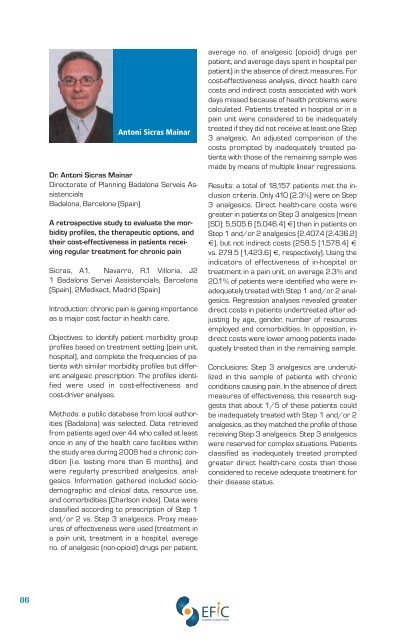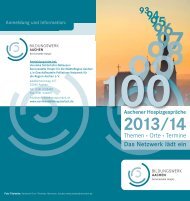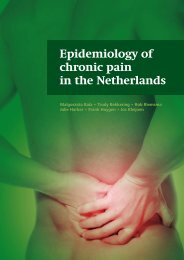First EFIC® Symposium Societal Impact of Pain - SIP
First EFIC® Symposium Societal Impact of Pain - SIP
First EFIC® Symposium Societal Impact of Pain - SIP
You also want an ePaper? Increase the reach of your titles
YUMPU automatically turns print PDFs into web optimized ePapers that Google loves.
86<br />
Antoni Sicras Mainar<br />
Dr. Antoni Sicras Mainar<br />
Directorate <strong>of</strong> Planning Badalona Serveis Assistencials<br />
Badalona, Barcelona (Spain)<br />
A retrospective study to evaluate the morbidity<br />
pr<strong>of</strong>iles, the therapeutic options, and<br />
their cost-effectiveness in patients receiving<br />
regular treatment for chronic pain<br />
Sicras, A1, Navarro, R,1 Villoria, J2<br />
1 Badalona Servei Assistencials, Barcelona<br />
(Spain), 2Medixact, Madrid (Spain)<br />
Introduction: chronic pain is gaining importance<br />
as a major cost factor in health care.<br />
Objectives: to identify patient morbidity group<br />
pr<strong>of</strong>iles based on treatment setting (pain unit,<br />
hospital), and complete the frequencies <strong>of</strong> patients<br />
with similar morbidity pr<strong>of</strong>iles but different<br />
analgesic prescription. The pr<strong>of</strong>iles identified<br />
were used in cost-effectiveness and<br />
cost-driver analyses.<br />
Methods: a public database from local authorities<br />
(Badalona) was selected. Data retrieved<br />
from patients aged over 44 who called at least<br />
once in any <strong>of</strong> the health care facilities within<br />
the study area during 2008 had a chronic condition<br />
(i.e. lasting more than 6 months), and<br />
were regularly prescribed analgesics. analgesics.<br />
Information gathered included sociodemographic<br />
and clinical data, resource use,<br />
and comorbidities (Charlson index). Data were<br />
classified according to prescription <strong>of</strong> Step 1<br />
and/or 2 vs. Step 3 analgesics. Proxy measures<br />
<strong>of</strong> effectiveness were used (treatment in<br />
a pain unit, treatment in a hospital, average<br />
no. <strong>of</strong> analgesic (non-opioid) drugs per patient,<br />
average no. <strong>of</strong> analgesic (opioid) drugs per<br />
patient, and average days spent in hospital per<br />
patient) in the absence <strong>of</strong> direct measures. For<br />
cost-effectiveness analysis, direct health care<br />
costs and indirect costs associated with work<br />
days missed because <strong>of</strong> health problems were<br />
calculated. Patients treated in hospital or in a<br />
pain unit were considered to be inadequately<br />
treated if they did not receive at least one Step<br />
3 analgesic. An adjusted comparison <strong>of</strong> the<br />
costs prompted by inadequately treated patients<br />
with those <strong>of</strong> the remaining sample was<br />
made by means <strong>of</strong> multiple linear regressions.<br />
Results: a total <strong>of</strong> 18,157 patients met the inclusion<br />
criteria. Only 410 (2.3%) were on Step<br />
3 analgesics. Direct health-care costs were<br />
greater in patients on Step 3 analgesics (mean<br />
[SD]: 5,505.6 [5,046.4] €) than in patients on<br />
Step 1 and/or 2 analgesics (2,407.4 [2,436.2]<br />
€), but not indirect costs (258.5 [1,578.4] €<br />
vs. 279.5 [1,423.6] €, respectively). Using the<br />
indicators <strong>of</strong> effectiveness <strong>of</strong> in-hospital or<br />
treatment in a pain unit, on average 2.3% and<br />
20.1% <strong>of</strong> patients were identified who were inadequately<br />
treated with Step 1 and/or 2 analgesics.<br />
Regression analyses revealed greater<br />
direct costs in patients undertreated after adjusting<br />
by age, gender, number <strong>of</strong> resources<br />
employed and comorbidities. In opposition, indirect<br />
costs were lower among patients inadequately<br />
treated than in the remaining sample.<br />
Conclusions: Step 3 analgesics are underutilized<br />
in this sample <strong>of</strong> patients with chronic<br />
conditions causing pain. In the absence <strong>of</strong> direct<br />
measures <strong>of</strong> effectiveness, this research suggests<br />
that about 1/5 <strong>of</strong> these patients could<br />
be inadequately treated with Step 1 and/or 2<br />
analgesics, as they matched the pr<strong>of</strong>ile <strong>of</strong> those<br />
receiving Step 3 analgesics. Step 3 analgesics<br />
were reserved for complex situations. Patients<br />
classified as inadequately treated prompted<br />
greater direct health-care costs than those<br />
considered to receive adequate treatment for<br />
their disease status.






